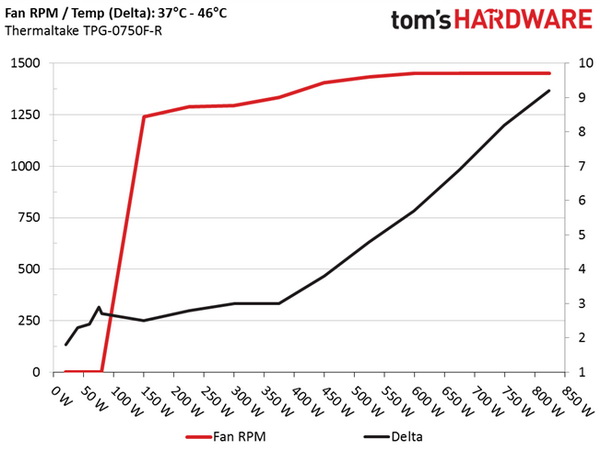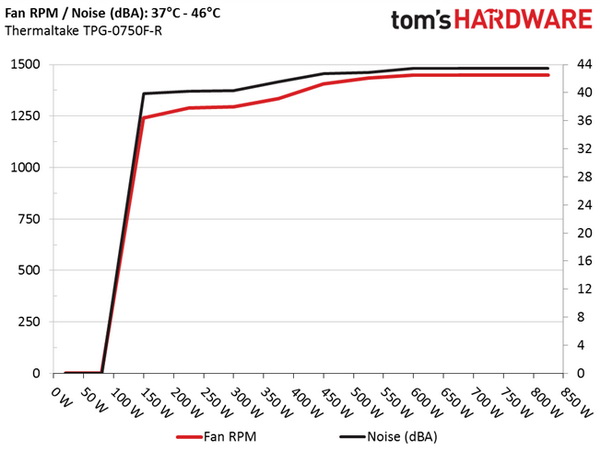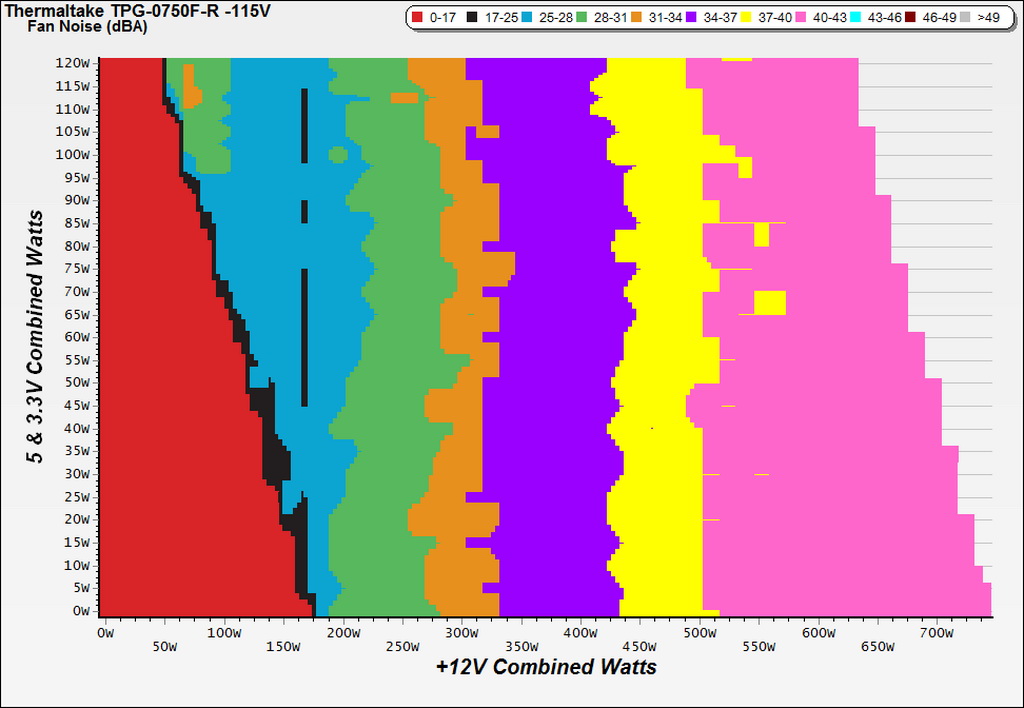Thermaltake Toughpower Grand RGB 750W PSU Review
RGB LED lighting is the new hotness, and a lot of power supplies are incorporating it. Thermaltake's Toughpower Grand RGB with 750W of maximum power boasts RGB lighting, surprisingly good performance, and modular cabling.
Why you can trust Tom's Hardware
Efficiency, Temperature, And Noise
Efficiency
Our efficiency testing procedure is detailed here.
Using results from the previous page, we plotted a chart showing the TPG-0750F-R's efficiency at low loads, and loads from 10 to 110 percent of its maximum-rated capacity.
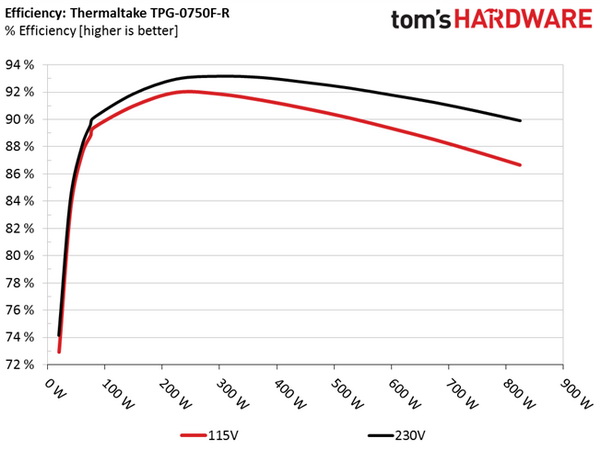
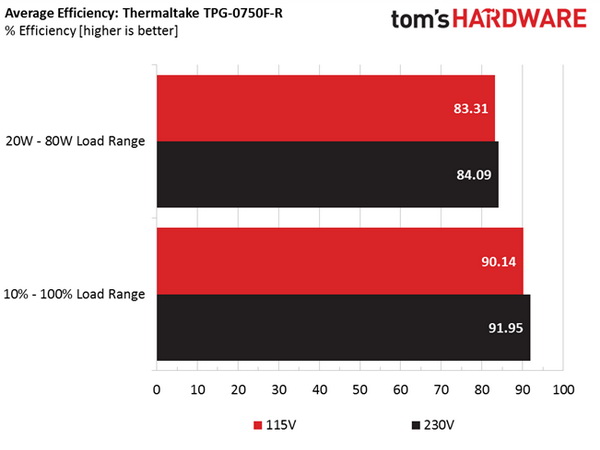
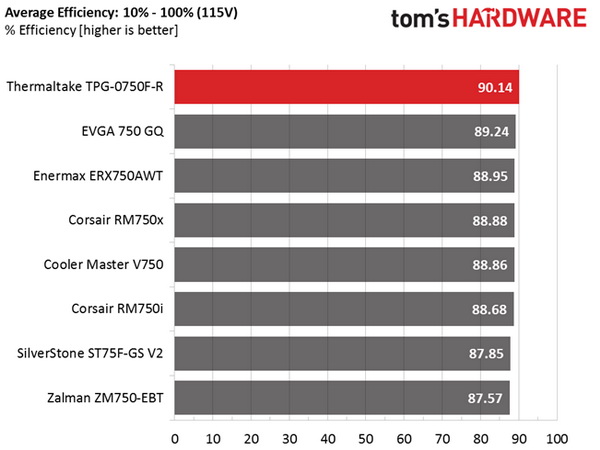
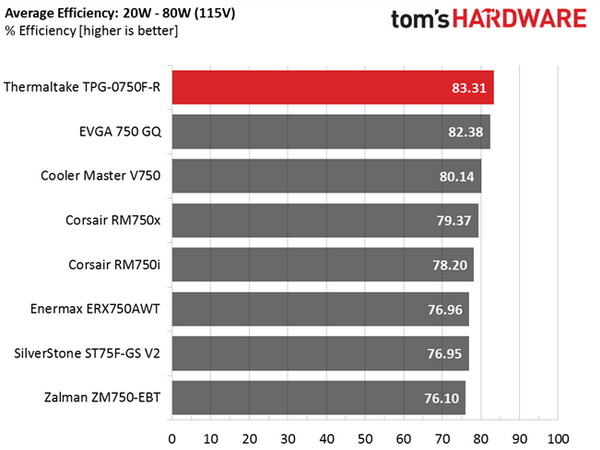
The TPG-0750F-R is significantly more efficient than competing Gold-class units, including those from Zalman and SilverStone based on a similar platform. According to our data, it even beats the Platinum-rated SilverStone ST75F-PT, which achieves 89.88% overall efficiency between 10% to 100% of its output range, and 81.41% between 20W and 80W.
It bothered us that we couldn't explain this discrepancy, so we asked around and discovered that Thermaltake is using the latest version of Sirfa's platform for its TPG-0750F-R. Apparently, the new revision enables significantly better performance than older ones.
Efficiency At Low Loads
In the following tests, we measure the TPG-0750F-R's efficiency at loads significantly lower than 10 percent of its maximum capacity (the lowest load the 80 PLUS standard measures). The loads we dialed were 20, 40, 60, and 80W. This is important for representing when a PC is idle, with power-saving features turned on.
| Test # | 12V | 5V | 3.3V | 5VSB | DC/AC (Watts) | Efficiency | Fan Speed | Fan Noise | PF/AC Volts |
|---|---|---|---|---|---|---|---|---|---|
| 1 | 1.193A | 0.491A | 0.474A | 0.196A | 19.69 | 72.919% | 0 RPM | 0 dB(A) | 0.888 |
| 12.237V | 5.090V | 3.360V | 5.083V | 27.00 | 115.03V | ||||
| 2 | 2.412A | 0.978A | 0.981A | 0.391A | 39.76 | 83.438% | 0 RPM | 0 dB(A) | 0.940 |
| 12.232V | 5.089V | 3.356V | 5.076V | 47.65 | 115.03V | ||||
| 3 | 3.635A | 1.466A | 1.488A | 5.070A | 59.89 | 87.484% | 0 RPM | 0 dB(A) | 0.961 |
| 12.227V | 5.088V | 3.353V | 5.070V | 68.46 | 115.04V | ||||
| 4 | 4.846A | 1.963A | 1.967A | 0.787A | 79.79 | 89.377% | 0 RPM | 0 dB(A) | 0.974 |
| 12.222V | 5.087V | 3.350V | 5.064V | 89.27 | 115.08V |
Efficiency is very high under light loads, even for a Gold-rated unit, and the PSU operates passively, so it's completely inaudible.
5VSB Efficiency
The ATX specification states that 5VSB supply efficiency should be as high as possible, recommending 50 percent or higher with 100mA of load, 60 percent or higher with 250mA of load, and 70 percent or higher with 1A or more of load.
Get Tom's Hardware's best news and in-depth reviews, straight to your inbox.
We take four measurements: one each at 100, 250, and 1000mA, and one with the full load the 5VSB rail can handle.
| Test # | 5VSB | DC/AC (Watts) | Efficiency | PF/AC Volts |
|---|---|---|---|---|
| 1 | 0.102A | 0.523 | 73.766% | 0.100 |
| 5.124V | 0.709 | 115.08V | ||
| 2 | 0.252A | 1.290 | 78.707% | 0.190 |
| 5.118V | 1.639 | 115.08V | ||
| 3 | 1.002A | 5.100 | 81.574% | 0.320 |
| 5.090V | 6.252 | 115.08V | ||
| 4 | 3.002A | 15.052 | 79.367% | 0.382 |
| 5.014V | 18.965 | 115.07V |
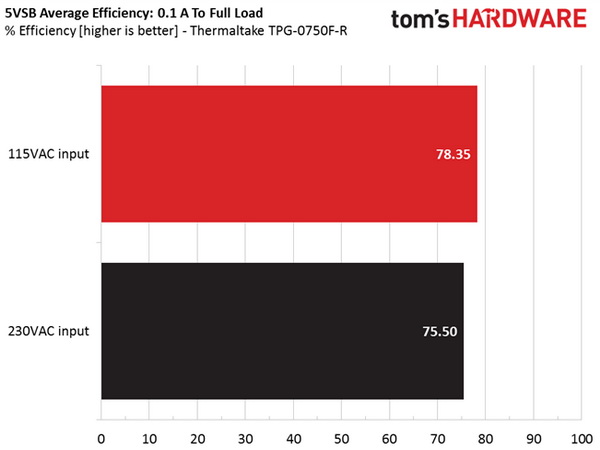
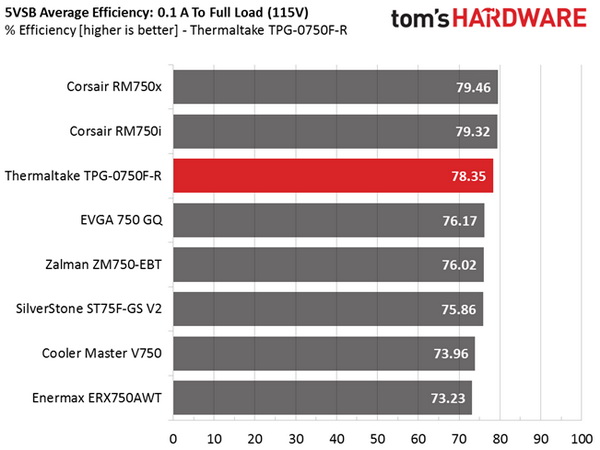
The 5VSB rail is also highly efficient; it only loses to the RMx and RMi units.
Power Consumption In Idle And Standby
In the table below, you'll find the power consumption and voltage values of all rails (except -12V) when the PSU is idle (powered on, but without any load on its rails), and the power consumption when the PSU is in standby mode (without any load, at 5VSB).
| Mode | 12V | 5V | 3.3V | 5VSB | Watts | PF/AC Volts |
|---|---|---|---|---|---|---|
| Idle | 12.241V | 5.091V | 3.363V | 5.092V | 8.038 | 0.591 |
| 115.1V | ||||||
| Standby | 0.0784 | 0.012 | ||||
| 115.1V |
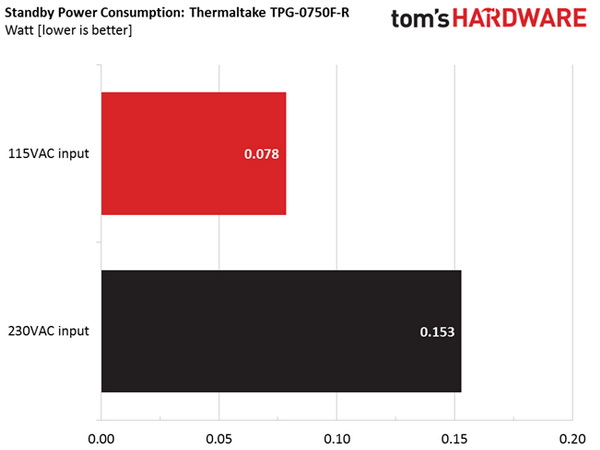
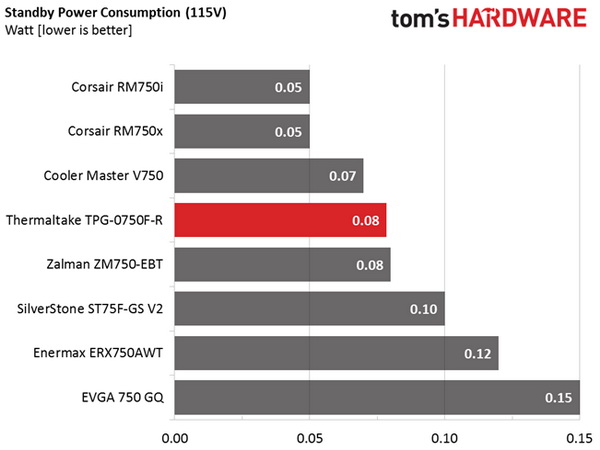
Power consumption in standby isn't the lowest we've seen, but it's still a lot lower than what the ErP Lot 6 2013 specification requires.
Fan RPM, Delta Temperature, And Output Noise
Our mixed noise testing is described in detail here.
The first chart illustrates the cooling fan's speed (in RPM), and the delta between input and output temperature. The results were obtained at 37°C (98.6°F) to 46°C (114.8°F) ambient temperature.
The next chart shows the cooling fan's speed (again, in RPM) and output noise. We measured acoustics from one meter away, inside a small, custom-made anechoic chamber with internals completely covered in sound-proofing material (be quiet! Noise Absorber kit). Background noise inside the chamber was below 18 dB(A) during testing, and the results were obtained with the PSU operating at 37°C (98.6°F) to 46°C (114.8°F) ambient temperature.
The following graph illustrates the fan's output noise over the PSU's operating range. The same conditions of the above graph apply to our measurements, though the ambient temperature was between at 30°C (86°F) to 32°C (89.6°F).
Passive mode doesn't last long, even under normal ambient temperatures. Nonetheless, the PSU is fairly quiet up to around 300W load, while it exceeds 40 dB(A) with more than 500W load. All in all, the fan profile could be less aggressive to facilitate quieter operation.
Current page: Efficiency, Temperature, And Noise
Prev Page Load Regulation, Hold-Up Time, And Inrush Current Next Page Protection Features, Evaluated
Aris Mpitziopoulos is a contributing editor at Tom's Hardware, covering PSUs.
-
shrapnel_indie Has anyone tested this claim of a cooler PC with the PSU fan facing up into the case instead of down and drawing air from outside?Reply
Edit: I see with at least this unit, it was found to be so, What about other units? -
Phillip Wager I have my computer case in a dusty area of my house and on the floor. i flipped my psu fan to face inside the case because i was sick of having to clean the dust filter every week or so. I'm paranoid about psu dust death. I have PLENTY of case fans(5) so i'm not worried about the psu overheating in this configuration.Reply -
Malik 722 but mounting power supply fan side up won't suck in hot air from the chassis and increase the power supply temperature.Reply -
Virtual_Singularity Reply19328496 said:I want it, for my Asus
Cool
Na, you really don't, you can do better methinks. -
blackmagnum "It's common knowledge that hot air rises, so if we want to improve airflow inside a chassis, we have to help move hot air up and out with fans installed on the top or back. We'll have to revisit this topic in a story about PSU orientation and its effect on case cooling."Reply
-I'll be looking forward to the article. -
SeoulFood I just won this PSU at a LAN this past weekend. I would use it, but I won a Silverstone 850w at the last LAN. Craigslist here we come.Reply
